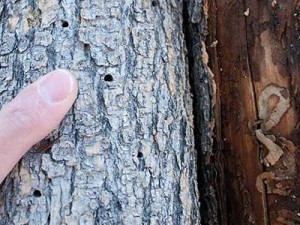
FORT COLLINS, Colo. – The Colorado State Forest Service has just released two new online videos to help Colorado homeowners and communities prepare for an imminent threat to millions of trees in the state – the emerald ash borer (EAB).
EAB is a highly destructive, non-native insect that infests and kills all North American true ash species. The pest, which already has cost communities in the eastern U.S. billions of dollars, was first detected in the City of Boulder in 2013. It has not yet been detected in Colorado outside of the city, but now threatens an estimated 15 percent or more of Colorado’s urban and community trees.
Focus of Videos
- How to identify ash trees, which are found widely in backyards, parks and along streets around the state
- How to recognize symptoms of EAB infestation in an ash tree, as opposed to other factors impacting the health of ash trees in Colorado
“Right now, what’s important is helping communities and property owners figure out if they have ash trees, and if so, knowing what to be thinking about with regards to management options for those trees,” said Keith Wood, CSFS community forestry program manager.
Ash Identification Video
The new ash identification video visually depicts the basic traits to look for in a tree to easily determine if it is an ash tree, which would make it susceptible to EAB and in the future may require treatment or removal.

Does My Ash Tree Have EAB?
For homeowners and businesses that do have ash trees, the other video covers various symptoms to look for to determine if a tree is infested by EAB or has other health issues. Wood says the intent is to ensure that if or when EAB arrives in communities outside of Boulder, property owners will already know if they have an ash tree and have an idea what to look for to determine if EAB could be present.
Plant Diverse Tree Species When Replacing Ash Trees
The CSFS also just released another video on how to properly plant trees. While the video applies to the planting of almost any tree type in Colorado and for any reason, it too has significance regarding EAB management.
“One aspect of preparing for EAB is the need to plant diverse tree species now, as these trees may eventually replace ash trees lost to the pest,” Wood says.
More than 15 Colorado municipalities, mostly along the Front Range, already are pre-emptively replacing public ash trees in 2016 with plantings of other tree species – putting thousands of new trees in the ground this year to address EAB’s presence in the state and the threat of its eminent spread.
CSFS Works with Partner Organizations
The CSFS works with partner organizations and agencies on the Colorado Emerald Ash Borer Response Team to help communities manage the spread and impacts of EAB. Team response efforts have included:
- surveys to determine the extent of spread of EAB;
- hosting EAB identification workshops;
- education and outreach efforts;
- the release of stingless, parasitic wasps that target and kill EAB; and
- establishing a quarantine for Boulder County and surrounding areas to help prevent the movement of potentially infested wood.
Learn More
View the ash tree identification and EAB symptoms videos or find more information about Emerald Ash Borer on our EAB page.
Additional EAB resources also can be found at www.eabcolorado.com.

